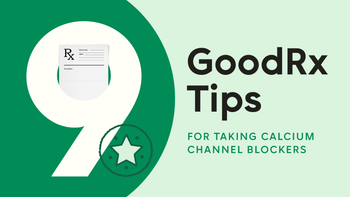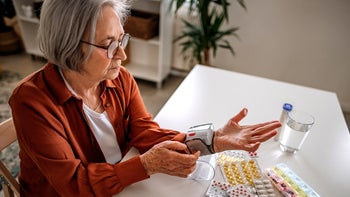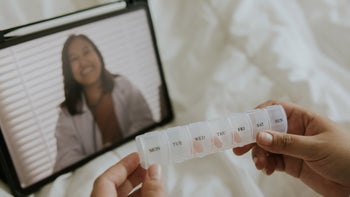
What’s It Like to Take Amlodipine for High Blood Pressure?
Key takeaways:
Amlodipine, one of the most commonly prescribed medications in the country, helps people with hypertension lower their blood pressure levels.
Those who take amlodipine tell GoodRx that the medication has generally been effective at lowering their blood pressure.
Side effects such as swelling and tiredness may get better over time as your body gets used to amlodipine.
Access savings on related medications

Amlodipine, a blood pressure medication, is among the most prescribed medications in the country.
Amlodipine is the generic for brand names like Norvasc, Norliqva, and Katerzia. It belongs to a class of medications called calcium channel blockers. It is considered a first-choice medication for helping people with high blood pressure (hypertension) lower those levels.
Three people who take or have taken amlodipine say that it is effective at reducing high blood pressure but caution against the potential for the most common side effect: swelling of the legs and ankles (edema).
Search and compare options
‘My blood pressure has settled down’
Jeremy Matthey thought he was just having an anxiety attack. Jeremy, a 40-year-old graphic designer in North Little Rock, Arkansas, says his mind was racing with workload and deadline concerns by the time he entered his doctor’s office for a routine checkup. His blood pressure reading was 200/90. “My doctor was like, ‘This blood pressure is too high for someone your age,’ and told me to go to the emergency room.”

A normal blood pressure measurement is when the top number — called systolic pressure — is less than 120 and the bottom number — the diastolic pressure — is less than 80. Blood pressure is considered elevated when the top number is between 120 and 129 and the bottom number is less than 80. Hypertension, or high blood pressure, is indicated by a top number above 130 or a bottom number above 80.
Jeremy drove himself to the hospital. He was treated with IV medications and fluids until his blood pressure stabilized and was sent home with a prescription for lisinopril to treat his hypertension.
“Heart disease runs on my mother’s side of the family,” Jeremy says, but he hadn’t previously been diagnosed. Although the lisinopril stabilized his blood pressure, for 3 months he struggled with a persistent dry, hacking cough, which is one of the medication’s known side effects. His doctor switched him to amlodipine, and the coughing stopped.
On his most recent doctor visit, Jeremy’s blood pressure was around 117/70. “My blood pressure has settled down,” Jeremy says. “I’ve noticed if I don’t take [the amlodipine], I start feeling anxious, and my blood pressure does go up.”
The only lifestyle changes he’s made since the switch to amlodipine are: abstaining from grapefruit — known to interact with certain blood pressure medications; cutting back on salt; and being more active. However, he frequently experiences one of the medication’s rarer side effects: vivid dreams. ( His dreams could be a side effect of the propranolol he’s taking, since beta blockers are more well known to cause vivid dreams).
“It’s almost nightly,” he says. “Sometimes, I’ll wake up a couple of times a night if they get bad. There’ve been a couple of postapocalyptic ones with zombies and monsters. But I’d rather have those dreams than that cough.”
Jeremy takes 5 mg of amlodipine a day, along with propranolol and hydrochlorothiazide, a diuretic that also eases swelling (edema).
“I really feel happy and healthy with the regimen I’m on,” he says. “If I had a choice between lisinopril and amlodipine, I’m definitely happier with amlodipine.”
Amlodipine worked well for 4 years
Like Jeremy, Angie Aldaiz can trace her hypertension back to her mother’s side of the family. Although Angie’s been taking amlodipine for 5 years, she plans to ask her doctor soon about switching to a different blood pressure medication. “I just don’t think the amlodipine is working anymore,” she says.
Angie, who is 43, says the medication worked fine at first. “It worked well for 4 years,” when her blood pressure reading was around 140/90. This year? “My blood pressure has been shooting up really bad. I’ve been hospitalized with extremely high blood pressure several times.”

In July 2023, Angie’s blood pressure shot up to 209/113, so her doctor added lisinopril to her blood pressure regimen. That dropped her blood pressure to around 180/100 — still well above what’s considered normal.
Angie took medical retirement from the Army in 2010, after she and several other soldiers fell into a trench during a training exercise. Angie suffered a broken leg, back, and neck. Her long journey to healing includes taking fluoxetine (Prozac) and mirtazapine (Remeron) for depression. She’s been taking both medications for years, so the sudden blood pressure spikes have her baffled.
Angie takes 10 mg of amlodipine each day. The San Antonio, Texas, resident also checks her blood pressure daily using a home digital monitor, which sends the results to her telehealth nurse. At her next 3-month checkup, Angie says, she will talk to her doctor about switching from amlodipine to a medication that would get her blood pressure back under control. Still, she recommends amlodipine to others.
“It worked for me for years. If it’s working for you, why not continue? It doesn’t have that many side effects, either.”
The swelling was just too much
Robert Carver’s doctor immediately granted his request to discontinue amlodipine just one month after he started it. The reason? The medication’s most common side effect: swelling of the legs and ankles (edema).
“My whole lower leg started to swell and, basically, I could not see my ankles,” says Robert, who is 61 and lives in Baton Rouge, Louisiana. “I looked like somebody with elephantiasis.”

Robert had been diagnosed with hypertension just 2 months before being prescribed amlodipine. The first two medications he tried were hit-and-miss, he says. The third, amlodipine, worked like a charm. “My blood pressure was in the 160s over 85,” he says. “Amlodipine got me down to the 130s quite easily.”
Robert’s doctor started him on a daily dosage of 5 mg of amlodipine for 2 weeks. There was some blood pressure reduction, but not as significant as was ideal, Robert says, so his doctor increased the dosage to 10 mg. When his lower legs began to swell, Robert immediately knew why.
“One thing I do is read up on every medication I get. I knew about edema being an issue. And I thought, ‘OK, maybe it won’t be an issue with me.’ But, apparently, it’s more prevalent at the higher doses, and that’s when it happened.”
The swelling caused stiffness that extended to his knees. “I’m somebody who’s got some bad knees anyway, and normally my Celebrex (celecoxib) controls that very well, but the blood pressure medicine, unfortunately, caused my joints to feel very puffy and stiff. It’s made being active much more difficult.”
Two weeks later, Robert’s doctor replaced amlodipine with what’s now the fourth blood pressure medication he’s tried, chlorthalidone (Thalitone), which acts as a diuretic. It took about a week for his legs to return to normal.
Robert cautions everyone to research their medications to understand the potential side effects.
What does the pharmacist say?

Stacia Woodcock, PharmD
Pharmacy Editor
Amlodipine (Norvasc, Katerzia) is a calcium channel blocker that’s often prescribed for high blood pressure and coronary artery disease. It’s considered a first-choice treatment for high blood pressure, and it may also work better than other blood pressure medications for Black adults.
You can take amlodipine at any time of day, with or without food. But be consistent with how and when you take it for best results. And it’s recommended that you avoid grapefruit and grapefruit juice while taking it. Grapefruit can increase amlodipine levels in your body, which can make side effects more likely.
Amlodipine is generally well tolerated by most people, but it does have side effects to be aware of. You may notice swelling in your legs or ankles or feel more tired than usual. It’s also possible to feel dizzy, especially when you sit up or stand too quickly. These side effects are more likely with the higher, 10 mg dose of amlodipine.
Most amlodipine side effects improve over time as your body gets used to the medication. But if they worsen or are bothersome, let your healthcare provider know. It’s also a good idea to review your medication list with your provider before you start taking amlodipine. This can help them make sure there aren’t any potential drug interactions that could affect how amlodipine works for you.
Why trust our experts?



Was this page helpful?
Related Articles
Browse medications
View AllResearch prescriptions and over-the-counter medications from A to Z, compare drug prices, and start saving.




























